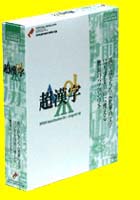


Personal Media Corporation's announcement that it will begin marketing in the middle of November 1999 a new version of its BTRON3-specification operating system with an unabridged Japanese character set received massive coverage in the Japanese media. (Click here for a list of links.) In addition to leading Japanese newspapers, the story was carried by many regional newspapers, national magazines, and major television networks, such as Fuji Television Network, TV-Asahi, and Japan Broadcasting Corporation (NHK).
To kick off its new marketing campaign for B-right/V R2, which Personal Media has nicknamed Cho Kanji (Ultra Kanji), the company is offering a free upgrade service for customers who purchased the previous release, B-right/V R1.1, during its summer sales campaign of 1999. The company is also offering a 1,000 yen cash rebate to customers who purchased other versions of its BTRON-specification operating systems (1B/V1, 1B/V2, 1B/V3, and B-right/V). Since B-right/V R2 is expected to retail for approximately 10,000 yen, that amounts to roughly a 10 percent rebate. Those who would like further information, can get it at this link, which is in Japanese.
One of the articles in the list of links mentioned above stated that B-right/V R2 will come with Point-to-Point Protocol (PPP) support, which is necessary for users who access the Internet through dial-up Internet Service Providers (ISPs). If this is true, B-right/V R2 users will be able to dial up their ISPs using only their modems. Previous versions of B-right/V are able to access the Internet via a Local Area Network (LAN) of the type used in companies or using a router with a dial-up function that supports PPP. (For a description of the latter, click here.)
The TRON Association displayed an exhibit at Com Japan 1999, which was held from November 2 through 5. In addition, it will display an exhibit at MST '99, which will be held from November 10 through 12. The exhibition site for both Com Japan 1999 and MST '99 is Tokyo Big Sight, which is located to the north of Haneda Airport in Tokyo.
Com Japan is a big event of the information and telecommunications industry in Japan. MST, which stands for "Microcomputer System and Tool Fair," is an event centered around embedded systems. During MST '99, on November 11 from 4:00 p.m. to 6:00 p.m., the TRON Association will also hold an ITRON special seminar titled, "Standardization Study Trends in the ITRON Project." Participation is free, but a reservation is required.
There was a report at Nikkei Electronics Online that US Software, a Hillsboro, Oregon-based firm specializing in embedded systems, is studying a merger of the GNU/Linux operating system and micro-ITRON. Considering that the company works with large Japanese semiconductor chip makers, such as Fujitsu, Ltd, Hitachi, Ltd., and NEC Corporation, and that those companies are all producing micro-ITRON-specification kernels, the report seems plausible. However, the merger of an ITRON-specification kernel with Unix-style operating systems to streamline software development is not something new. Work along these lines actually dates back to the beginning of the TRON Project 15 years ago, when an ITRON-specification kernel was merged with the UNIX operating system.
TRON Web recommends that any firm considering merging GNU/Linux-based software packages with TRON-specification operating systems (OSs) should also consider the micro-CTRON-specification operating system. As is the case with ITRON, there is a freeware version available for downloading from the Internet, and since it is multiuser, multitask OS that contains no human-machine interface (HMI) specifications, it can easily be applied to a wide variety of processing tasks in other countries. In fact, micro-CTRON is already being applied to factory automation applications in China, so there is a market into which such a product could be sold.
Matsushita Graphic Communication Systems Inc. has merged its own one-chip facsimile engine with a micro-TRON-specification kernel, thus realizing facsimile, telephone, and e-mail functions with high-speed, real-time processing. The resulting technology is used in Matsushita's "Panafax A5CL," a personal facsimile machine for home use that can display up to three lines of characters from a Japanese language e-mail message on a small liquid crystal display screen.
Personal Media Corporation's museum guidance system, the micro-BTRON operating system-based MGS-3000, was selected for use at the "Digital Impact on Living Exhibit--Japan in the Changing 21st Century," which is taking place at TEPIA Hall in the Kita Aoyama section of Tokyo. The exhibit, TEPIA Hall's twelfth, will run until March 24, 2000. For more information click here.
The TRON Association is planning to hold a study conference to discuss how to apply Personal Media Corporation's new operating system B-right/V R2, which has multilingual and unabridged Japanese character capabilities that can be used in a multinational environment. The study conference will be held on Tuesday, November 30, 1999, in the Golden Cup on the 3rd floor of the Tokyo Prince Hotel, which is located next to Tokyo Tower.
The conference will begin at 1:30 p.m. with a presentation by TRON Project Leader Prof. Ken Sakamura, who will discuss character codes and their implementation, which will be followed by a presentation by Mr. Akira Matsui of Personal Media Corporation and a free discussion that will last until 4:00 p.m. Participation is free but limited to 80 persons. Those wishing to attend should contact Mr. Matsumura of TRON Association by Friday, November 26, 1999.
E-mail: HHG03172@nifty.ne.jp
Tel: 03-3454-3191
Fax: 03-3454-3224